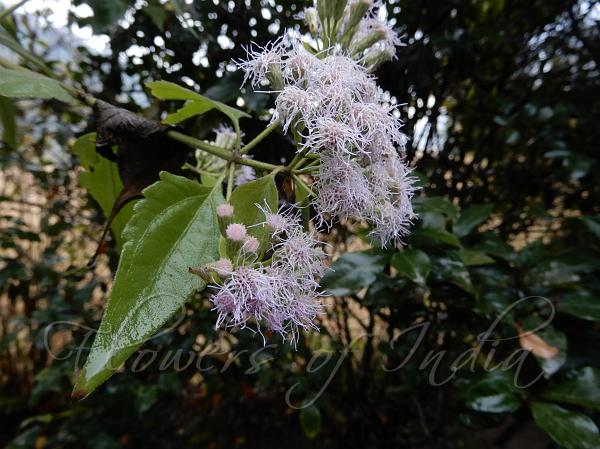|
| Siam Weed |
|

|

| File size | 484893 |
| Original date | 1/1/20 4:49 PM |
| Resolution | 3648 x 2736 |
| Flash | Flash did not fire, auto |
| Focal length | 4.3mm |
| Exposure time | 1/30s |
| Aperture | 3.4 |
| Focus Distance | |
| Metering Mode | Center weighted average |
| Camera make | NIKON |
| Camera model | COOLPIX A900 |
| Sensor type |
|
|
|
| Photo: |
Botanical name: Chromolaena odorata Family: Asteraceae (Sunflower family)
Synonyms: Eupatorium odoratum
Synonyms: Eupatorium odoratum
Siam Weed is a big bushy herb or subshrub with long rambling (but not
twining branches. In open areas it spreads into tangled, dense thickets up
to 2 m tall, and higher when climbing up vegetation. Many paired branches
grow off the main stem. The base of the plant becomes hard and woody while
the branch tips are soft and green. The leaves are arrowhead-shaped, 5–12
cm long and 3–7 cm wide, with three characteristic veins in a ‘pitchfork’
pattern. They grow in opposite pairs along the stems and branches. As the
species name ‘odorata’ suggests, the leaves emit a pungent odour when
crushed. Clusters of 10–35 pale pink–mauve or white tubular flowers, 10 mm
long, are found at the ends of branches. The seeds are dark coloured, 4–5
mm long, narrow and oblong, with a parachute of white hairs which turn
brown as the seed dries. Siam weed is native to Tropical America, but is now naturalized throughout the tropics.
Medicinal uses: It is used as a traditional medicine in Indonesia.
The young leaves are crushed, and the resulting liquid can be used to treat
skin wounds.
It is used as a traditional medicine in Indonesia.
The young leaves are crushed, and the resulting liquid can be used to treat
skin wounds.
Medicinal uses:
 It is used as a traditional medicine in Indonesia.
The young leaves are crushed, and the resulting liquid can be used to treat
skin wounds.
It is used as a traditional medicine in Indonesia.
The young leaves are crushed, and the resulting liquid can be used to treat
skin wounds.| Identification credit: S. Basu, Eby Abraham, Arunraj Kedharam | Photographed in Manipur, Maharashtra & Delhi. |
• Is this flower misidentified? If yes,